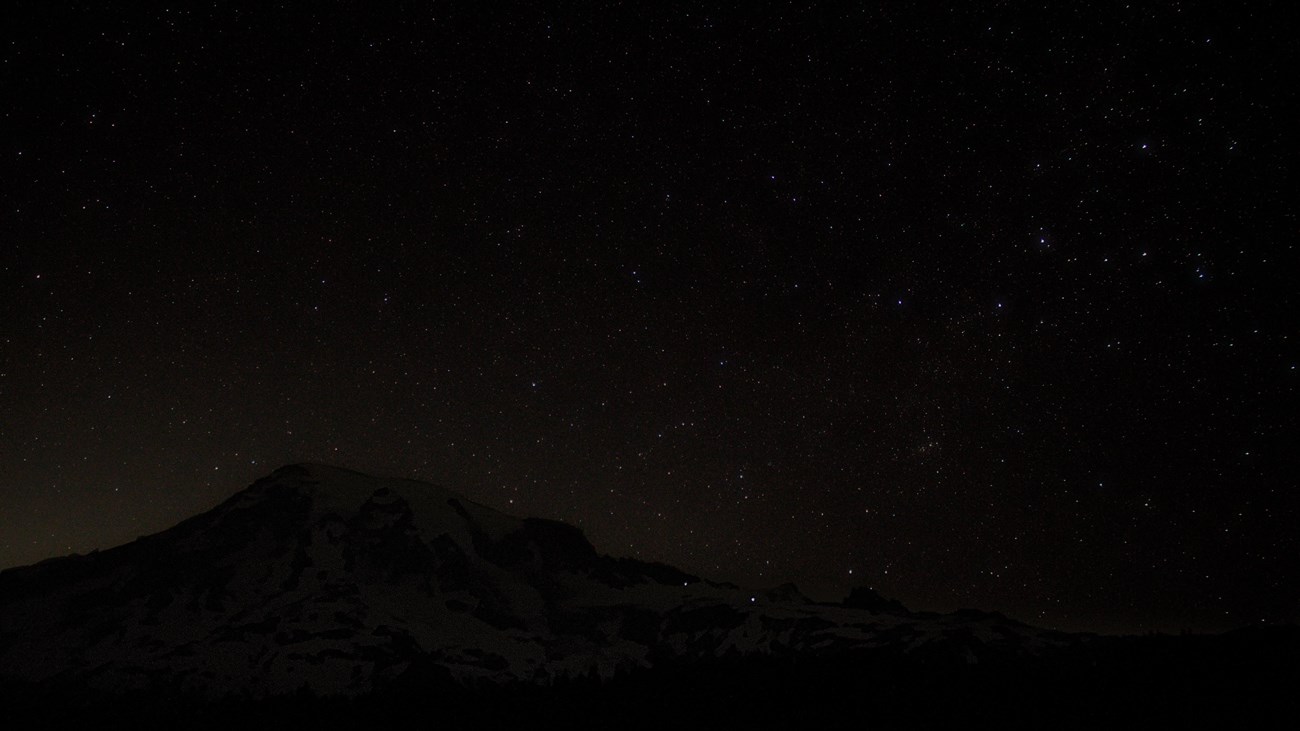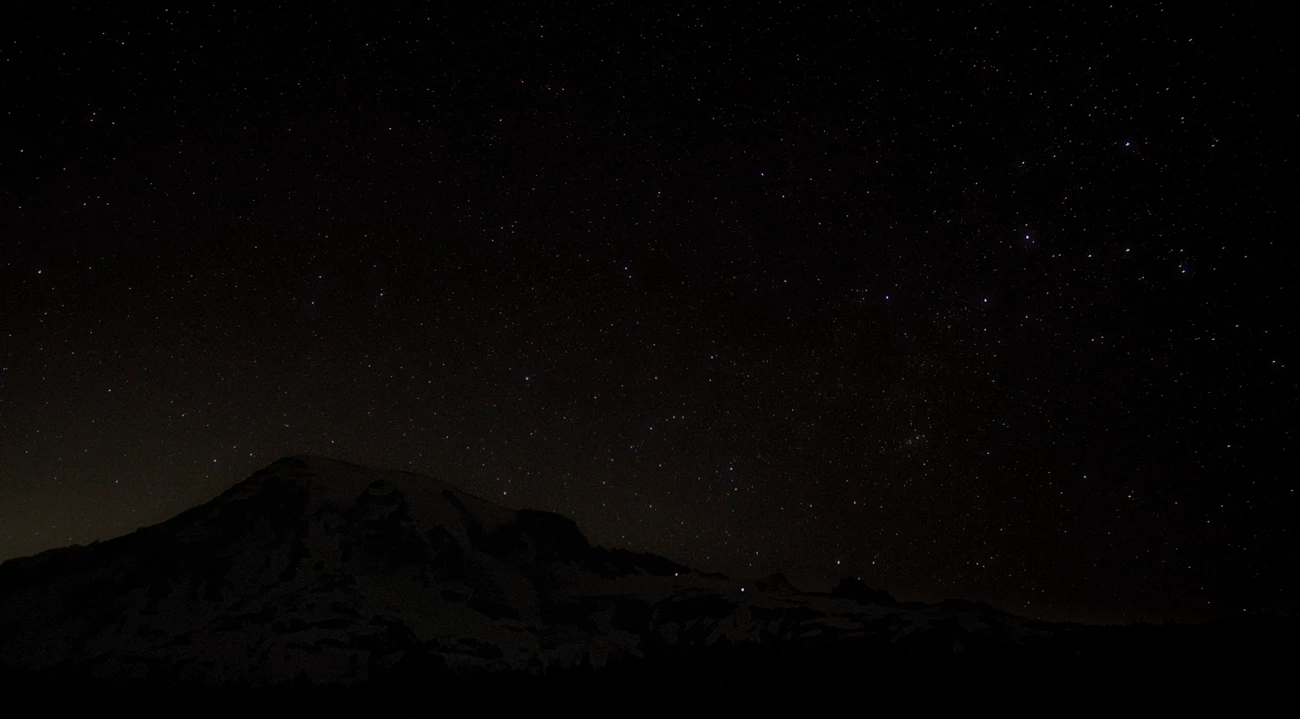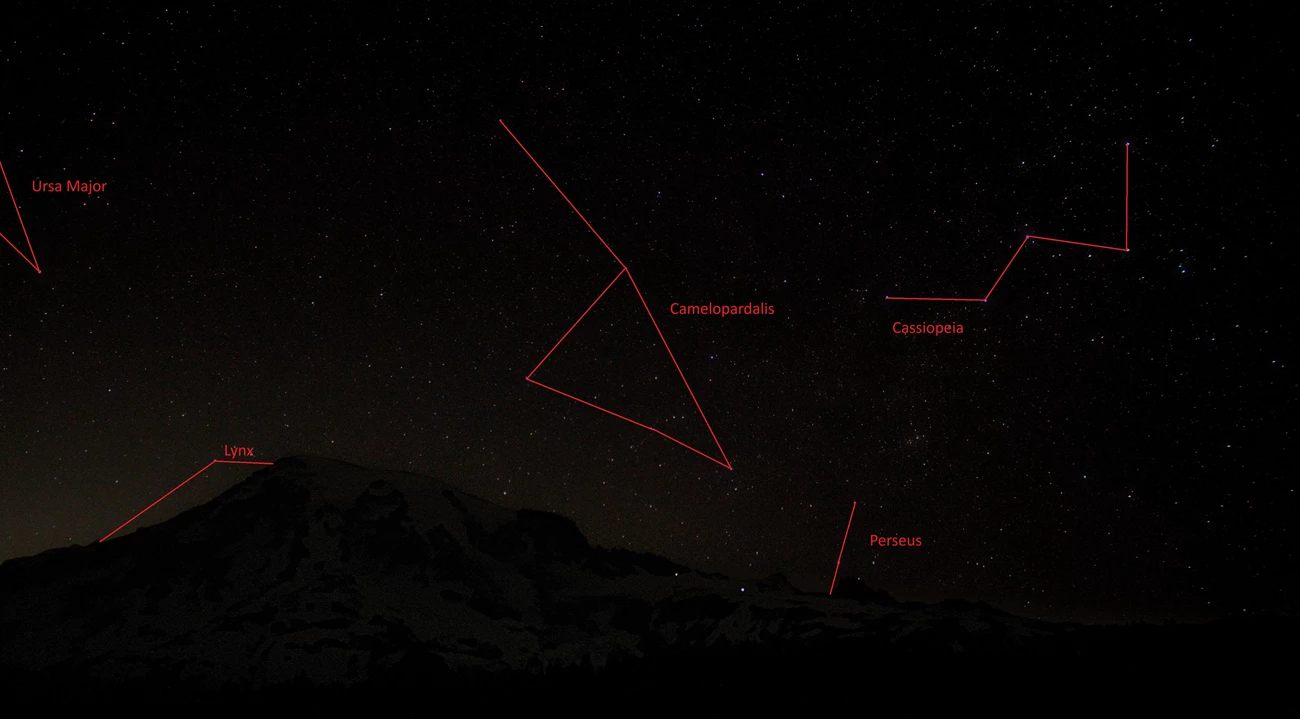Last updated: June 30, 2025
Thing to Do
Stargazing in Paradise & Stevens Canyon

NPS/J. Green Photo
While stargazing can be a relaxing and profound experience for many, extra precautions need to be taken to ensure you and your party’s safety while recreating in the dark. Night at Mount Rainier is not the darkest, but it can still be darker than most visitors are used to. Arrive 30 minutes before sunset to give yourself enough light to set up. It can take up to an hour for the sky to become dark enough to the faintest objects during the summer, but it can quickly become difficult to navigate after the sun sets.
After it gets dark, using a headlamp with a red light will provide necessary visibility and help protect your vision as it adjusts to the night. Keep your light pointed toward the ground so you can see where you are walking and never step backwards without looking first. Always monitor children when doing any activity at night.
It is important to limit white light usage (including phone usage if a red-light mode is unavailable) so your eyes can make out fainter objects in the night sky, like the Andromeda Galaxy or the Double Cluster. It can take up to 45 minutes for your eyes to adjust to the night, and that can all be undone by even the light of a flash photograph.
Seasonal access: Paradise is open year-round during the day, but night access is restricted in the winter. While night access is restricted to vehicles during the winter, backcountry campers will still find beautiful views from wherever they can find an open view of the sky. Stevens Canyon remains closed until the summer, typically open for the season from late May to October.
Outside of the Henry M. Jackson Memorial Visitor Center
Some of the most readily available parking can be found right outside of the Henry M. Jackson Memorial Visitor Center at Paradise. The plaza outside of the visitor center has seating and readily available space for visitors to set up in. Here, visitors can also find views of Mount Rainier aside northern constellations, like Ursa Major and Ursa Minor. To the south-east, visitors can appreciate the Tatoosh Mountain Range, as it underlines the rising ecliptic (which includes the sun, moon, planets, and the zodiac constellations). Keep track of what time the moon rises and try to predict where on the eastern horizon it might appear.
During July, August, and September, interpretive rangers host night sky programs in the Jackson Visitor Center Plaza. On cloudy nights, you can join rangers inside the Paradise Inn for indoor activities. Call the park’s astronomy hotline (360-569-6230) to learn more about night sky programming during the summer.
Twenty-four-hour restrooms are located on the east end of the plaza. If you decide to go onto a trail, be sure to hike in groups and remember that many large animals, like bears, are active at night. Bring a head lamp, hiking gear (such as the 10 essentials), and plenty of water. Pets are not allowed on any trails. Please stay on trail to avoid trampling the delicate subalpine meadow plants and wildflowers.
Roadside Pullouts
There are numerous paved roadside pullouts along Paradise Road, Paradise Valley Road, and Stevens Canyon Road. Many of them offer great views of the sky and other resources, but extra precautions need to be taken if set up on the side of the road.
Do not stop on the road and be sure to use only paved pullouts. Parking on unpaved and unofficial pullouts causes damage to delicate vegetation. Many pullouts do not have fencing. Be aware, as there are many steep drop-offs alongside the road and pullouts.
Always monitor children and pets when parked along the roadside. Be sure to wear high visibility gear (yellow or orange colors) so cars and other people can easily see you. While pets are allowed on paved sections of the road, pets are not allowed on any trail in the park.
Inspiration Point
Located on Stevens Canyon Road, Inspiration Point offers views further away from a visitor center and its lights, while still being easily accessible. Inspiration Point is a roadside parking lot 5 minutes from the Jackson Visitor Center. It offers another great view of Mount Rainier, while bringing visitors closer to the Tatoosh Mountain Range. Looking west, you can watch as objects on the ecliptic and southern constellations set. Looking at the western sky, you may notice a faint glow on the horizon. How does the western sky compare to other parts of the sky?
To get to Inspiration Point, you will turn onto Stevens Canyon Road, 4 minutes south of Paradise and 20 minutes north of Longmire. There are signs to direct you to Stevens Canyon Road along Paradise Road. Inspiration Point is one minute southeast on Stevens Canyon and is a small parking lot. When there at night, it is important to wear high visibility gear (yellow or orange in color) so cars and other people can easily see you. The nearest restrooms are located by the Jackson Visitor Center, on the east end of the plaza.
Reflection Lakes
One of the most popular stops in the park, Reflection Lakes provides visitors with pristine views of Mount Rainier. At night, it can offer a unique view of the sky. As you sit and look up at the stars, take a moment to turn your gaze down to the water. Can you make out any stars on the surface of the water?
Reflection Lakes is located 10 minutes from the Jackson Visitor Center along Stevens Canyon Road. There are two small parking areas available along the roadside, so there is limited room to set up and enjoy the stars. If parking here, be sure to wear high visibility gear (yellow or orange colors) so cars and other people can easily see you. The nearest restroom is located at the Jackson Visitor Center on the east end of the plaza.
Reflection Lakes is inaccessible during the winter, and trails are often still under feet of snow when Stevens Canyon Road first opens for the summer. Ask for current trail conditions to see if it is safe to go on the trails around Reflection Lakes during your visit. If safe, and you decide to go onto a trail, be sure to hike in groups and remember that many large animals, like bears, are active at night. Bring a head lamp, hiking gear such as the 10 essentials, and plenty of water. Pets are not allowed on trails. Please stay on trail to avoid trampling the delicate vegetation.
Box Canyon
Box Canyon sits to the east of Paradise and is a 25-minute drive on Stevens Canyon Road from the Jackson Visitor Center. There are parking spots near the outdoor exhibit panel, which looks southeast. Take a moment to listen to the forest around you while stargazing. Do you hear any evidence of the parks “night life,” any of the many nocturnal species that call the park home?
The closest bathrooms are located on the east end of the parking lot. If you decide to go on trail, be sure to hike in groups and remember that many large animals, like bears, are active at night. Bring a head lamp, hiking gear such as the 10 essentials, and plenty of water. Pets are not allowed on trails. Please stay on trail to avoid trampling the delicate vegetation.
Backbone Ridge
Backbone Ridge is located 10 minutes east on Stevens Canyon Road from Box Canyon. A large pullout on the side of the road facing west, this offers great views of objects as they set on the western horizon. What changes do you notice in the environment as it gets darker and darker?
The closest restrooms are located at Box Canyon, on the east end of the parking lot. If parking at Backbone Ridge, it is important to wear high visibility gear (yellow or orange in color) so cars and other people can easily see you.
Constellations above Mount Rainier


Left image
The starry sky above Mount Rainier.
Credit: NPS/J. Green Photo
Right image
The starry sky above Mount Rainier with some of the constellations marked.
Credit: NPS/J. Green Photo
